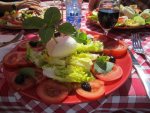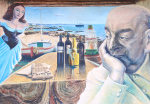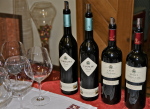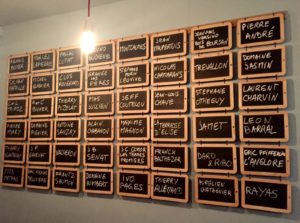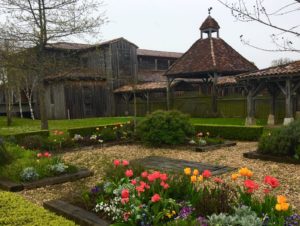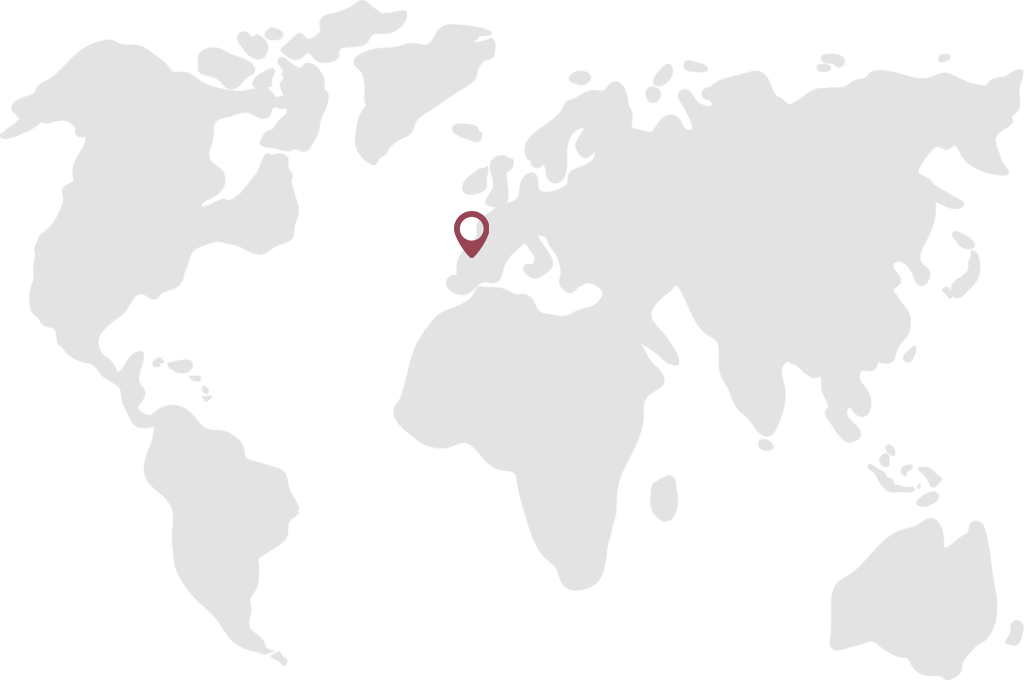A 2013 article from Smithsonian Magazine tells, basically, how French wine originated in Italy.

Before Roman society blossomed, the Etruscan civilization shone as a bright light of ingenuity, innovation, and civilization on the region of Italy now known as Tuscany. It was Etruscans, not Romans, who invented the structural arch above doorways, who laid out the fundamental rectilinear street system used to this day for city planning, and who first drained marshes to recover land used for agriculture throughout what is now Italy. The Etruscans were a hilltop dwelling, sometimes seafaring, bawdy lot who loved a good party, creatively concocted food, and who relished downing ample wine. Women enjoyed more respect than offered to females in Greek society and in the later Roman Empire. Many Etruscans belonged to the League of Twelve Cities, each city circled by defensive stone walls that followed contours of rolling landscapes.

I wrote about Etruscans in my fictional book River of Tuscany, with an excerpt quoted below.
The Greeks envy us! They criticize us as drunks, sneering that Etruscans taught Gauls the pleasure of wine. They scoff at how we treat women, saying we are too decent to them, which emboldens females with independent and adventurous spirits. They say we descended from Odysseus and his lover Circe and that we share their traits of shamelessness and promiscuity.
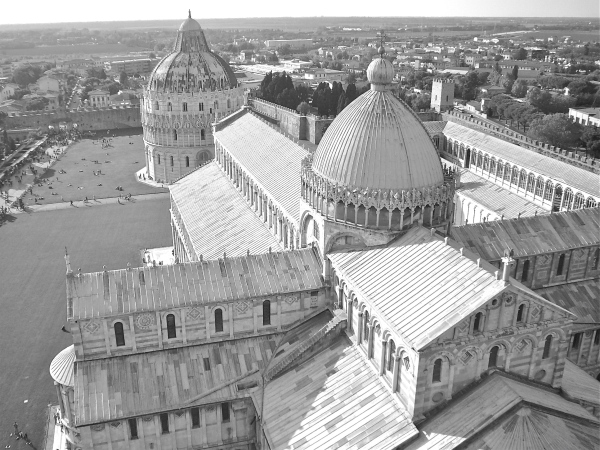
According to a recent article in the Proceedings of the National Academy of Sciences, chemical analyses of ancient amorphas used to carry wine in southern France – south of Montpellier – show these contained wine which originated in Etruria in what is today’s Italy – undoubtedly ferried there by ships. These amorphas were dated to between 525 and 475 BC. The wine also contained basil, rosemary, and pine resin – perhaps preservatives, perhaps additives for medicinal purposes.

DNA analysis of cattle in Tuscany shows that they descended from cattle brought to the Italian peninsula by seafaring immigrants. These people, who formed Etruria, were likely from Lydia, an Iron Age kingdom located in what is now western Turkey. They may have brought vitis vinifera grape species along, although ample wild grapes likely thrived on the peninsula already. Apparently Etruscans did not train their grapes or prune vines, and considered wine as both common and sacred: wine vessels were buried with bodies in tombs, and wine was used at religious and funerary ceremonies. The Etruscans also apparently liked to grate cheese into their wine to add flavor, and kept cheese graters on hand for visitors to any banquet.
By the second century BC Etruscan society was largely conquered by and absorbed into the growing Roman Empire.
What is the legacy of the Etruscan people? Tuscany. Home, eventually, to Florence – a city-state that flourished in the 1500’s because of its wealth, progressive notions and tolerance (sometimes, not always), as well as magnetism for bold and spirited Renaissance artists, thinkers, architects, engineers, bankers, and politicians. Today, the signature wine grape of Tuscany is Sangiovese (the primary grape in chianti, in Brunello di Montalcino, and in Vino Nobile di Montepulciano). What grape did the Etruscans use? We don’t know yet, though archaeological evidence will likely reveal that answer in the not distant future.
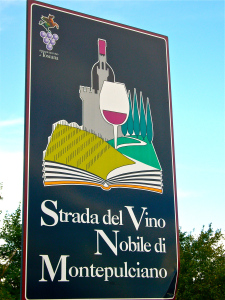
Interested in knowing more about Tuscany? A list of books about Tuscany is included at the end of this post.
Changes to Format –
Vino Video –
Want to read more about Tuscany? Below is a bibliography, compiled for the book River of Tuscany.
- Fortune Is a River, Roger D. Masters, Plume, New York, 1999
- The Hills of Tuscany, Ferenc Máté, Delta, New York, 1998
- The Etruscans, Raymond Bloch, Frederick A. Praeger Publishers, New York, 1958
- Hannibal: One Man Against Rome, Harold Lamb, Doubleday & Co., Inc., New York, 1958
- Pride of Carthage, David Anthony Durham, Doubleday, New York, 2005
- Hannibal – The General from Carthage, Ernle Bradford, McGraw-Hill Book Company, New York, 1981
- Leonardo Da Vinci – Engineer and Architect, The Montreal Museum of Fine Arts, Quebec, 1987
- Leonardo Da Vinci – Flights of the Mind, Charles Nicholl, Viking, New York, 2004
- Daily Life in the Middle Ages, by Paul B. Newman, McFarland & Company Publishers, Jefferson, North Carolina, 2001
- Tuscany in Mind, edited by Alice Leccese Powers, Vintage Departures, 2005
- In Tuscany, Frances Mayes, Edward Mayes, Bob Krist. Broadway Books, New York
- Under the Tuscan Sun, Frances Mayes, Broadway Books, New York, 1997
- Travelers’ Tales Italy, edited by Anne Calcagno, Travelers’ Tales, San Francisco, 2001
- The Medieval Kitchen: Recipes from France and Italy, Odile Redon, Francoise Sabban, Silvano Serventi, Univ. of Chicago Press, Chicago, 1998
- Science in the Kitchen and the Art of Eating Well, Pellegrino Artusi, University of Toronto Press, 2006
- A Taste of Tuscany, Eyewitness Travel Guides, DK Publishing Inc. New York, 2004
- The National Park of the Casentine Forests – where trees touch the sky, Giunti, Florence-Milan, 2003
- Vroom with a View, Peter Moore, Centro Books, New York, 2006
- Genius: A Mosaic of One Hundred Exemplary Creative Minds, by Harold Bloom, Warner Books, Inc. New York, 2002
- Dante, by Thomas G. Bergin, The Orion Press, New York, 1965
- Brunelleschi’s Dome – How a Renaissance Genius Reinvented Architecture, by Ross King; Penguin Books, New York, 2001
- La Bella Figura, Beppe Severgnini, Broadway Books, New York, 2006
- A Thousand Days in Tuscany, Marlena De Blasi
- The Most Beautiful Villages of Tuscany, James Bentley
- River of Tuscany (Rivers of Time Series), T. Mullen, Roundwood Press, 2013
- Fortune Is a River, Roger D. Masters, Plume, New York, 1999
- The Hills of Tuscany, Ferenc Máté, Delta, New York, 1998
- The Etruscans, Raymond Bloch, Frederick A. Praeger Publishers, New York, 1958
- Hannibal: One Man Against Rome, Harold Lamb, Doubleday & Co., Inc., New York, 1958
- Pride of Carthage, David Anthony Durham, Doubleday, New York, 2005
- Hannibal – The General from Carthage, Ernle Bradford, McGraw-Hill Book Company, New York, 1981
- Leonardo Da Vinci – Engineer and Architect, The Montreal Museum of Fine Arts, Quebec, 1987
- Leonardo Da Vinci – Flights of the Mind, Charles Nicholl, Viking, New York, 2004
- Daily Life in the Middle Ages, by Paul B. Newman, McFarland & Company Publishers, Jefferson, North Carolina, 2001
- Tuscany in Mind, edited by Alice Leccese Powers, Vintage Departures, 2005
- In Tuscany, Frances Mayes, Edward Mayes, Bob Krist. Broadway Books, New York
- Under the Tuscan Sun, Frances Mayes, Broadway Books, New York, 1997
- Travelers’ Tales Italy, edited by Anne Calcagno, Travelers’ Tales, San Francisco, 2001
- The Medieval Kitchen: Recipes from France and Italy, Odile Redon, Francoise Sabban, Silvano Serventi, Univ. of Chicago Press, Chicago, 1998
- Science in the Kitchen and the Art of Eating Well, Pellegrino Artusi, University of Toronto Press, 2006
- A Taste of Tuscany, Eyewitness Travel Guides, DK Publishing Inc. New York, 2004
- The National Park of the Casentine Forests – where trees touch the sky, Giunti, Florence-Milan, 2003
- Vroom with a View, Peter Moore, Centro Books, New York, 2006
- Genius: A Mosaic of One Hundred Exemplary Creative Minds, by Harold Bloom, Warner Books, Inc. New York, 2002
- Dante, by Thomas G. Bergin, The Orion Press, New York, 1965
- Brunelleschi’s Dome – How a Renaissance Genius Reinvented Architecture, by Ross King; Penguin Books, New York, 2001
- La Bella Figura, Beppe Severgnini, Broadway Books, New York, 2006
- A Thousand Days in Tuscany, Marlena De Blasi
- The Most Beautiful Villages of Tuscany, James Bentley
Also –
- The Etruscan World, Jean MacIntosh Turfa, Routledge, New York, 2013


